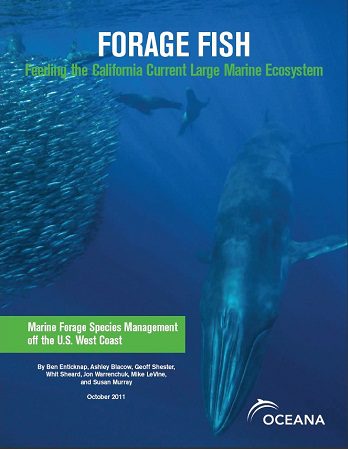Overview
Oceana works for concrete policy changes that protect forage species to maintain abundant wildlife populations and sustainable fisheries which depend on productive forage fish populations.

What Oceana Does
Forage Fish Worth More in the Ocean Than in the Net
Oceana is working at state and federal levels to improve management of existing fisheries targeting three of the top forage species off the U.S. West Coast (sardines, anchovies, and herring) and to prevent the development of new fisheries for forage species unless and until science can demonstrate that these fisheries may be conducted without harming the ecosystem. Building off its first ever “Fishery Ecosystem Plan”, we successfully worked with the Pacific Fishery Management Council to prohibit the development of new fisheries for seven groups of currently unmanaged forage species living in ocean waters off the U.S. West Coast; round and thread herrings, mesopelagic fishes, Pacific sandlance, Pacific saury, Osmerid smelts, Silversides, and pelagic squids. These groups encompass hundreds of species and a make-up a huge portion of the California Current food web. We are working with federal fishery managers to prevent overfishing to ensure there are enough Pacific sardines and Northern anchovies to support dependent predators, providing cutting-edge science and policy input. In 2012 we worked with the California Fish and Game Commission and other stakeholders to adopt a new state policy to manage California’s forage fisheries which officially recognizes the inordinately important role forage fish play in supporting healthy oceans. This policy establishes a new direction for fisheries on forage fish by considering how much to leave in the ocean to support the ecological, economic, and social values forage fish provide beyond their value in the fishing net. We are currently working with the state and stakeholders to implement this policy. Oceana is now working with other conservation groups, the State of California, and the fishing industry to develop a Fishery Management Plan for Pacific herring, one of the most important forage fish in the California Current ecosystem. Check out In the News for more details.
Not Enough Sardines for Sea Lions and Brown Pelicans
In 2013 over 1,600 California sea lion pups were admitted to rehabilitation facilities after being found stranded and malnourished. In 2014 the National Oceanic and Atmospheric Administration (NOAA) saw more stranded pups. NOAA determined “this event was not caused by disease rather by the lack of high quality, close-by food sources for nursing mothers” like Pacific sardine and Northern anchovy. These small, but important forage fish are also a critical food source for endangered California brown pelicans. Scientists completed a survey of pelican breeding colonies in Mexico’s Gulf of California in 2014 and found that areas that typically host hundreds or thousands of nesting pairs held only a few hundred at most, and in some cases zero nesting pairs. In 2015 and 2016, California sea lions and brown pelicans continued to suffer dire consequences due to a lack of food. Oceana is working to improve management of sardines and anchovy to ensure there is enough food for their predators.





